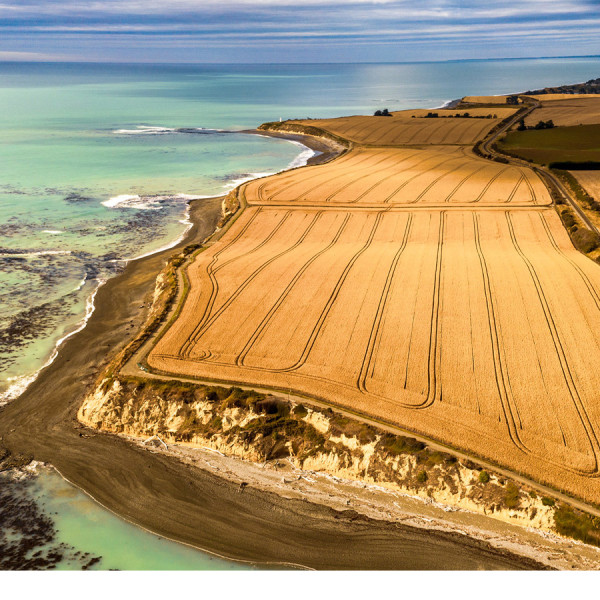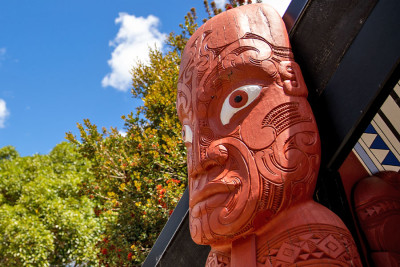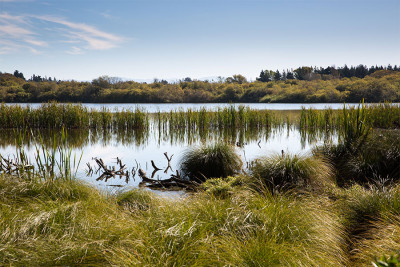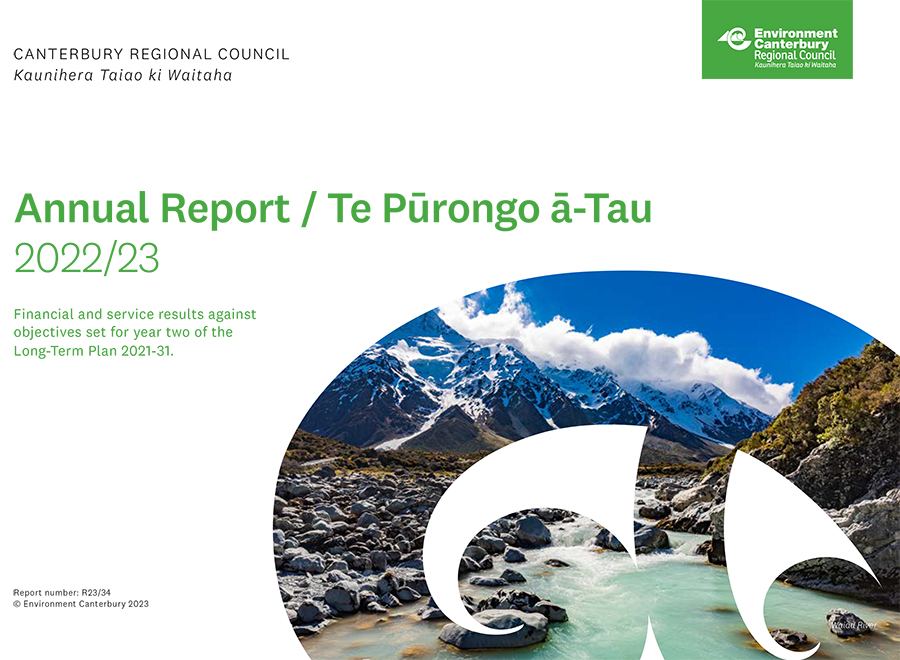A year in review
A year in review | He tau ki te arotake
The Canterbury region is Aotearoa New Zealand’s largest region covering 45,239 km² of diverse landscapes, including New Zealand’s highest mountain, major lakes and river systems, and some of the most productive farmland.
The region is the most populated in the South Island with most of the population concentrated around Greater Christchurch.
There are ten territorial local authorities in the Canterbury region: the Kaikōura, Hurunui, Waimakariri, Christchurch City Council, Ashburton, Selwyn, Timaru, Mackenzie, Waimate and Waitaki District Councils.
Activities, services and levels of service that we measure and report against are included in our Long Term Plan 2021–31.
Each Level of Service includes measures and targets relating to quantity, quality, reliability, responsiveness, environmental acceptability and cost, with performance assessed against these.
More information about the 40 levels of service is contained in the link to the full Annual Report (PDF File, 15.4MB) on each portfolio page.
How we performed in 2022/23
40 Levels of Service
30
Achieved
10
Not achieved
0
Not measured
103 Targets
89
Achieved
11
Not achieved
3
Not measured

From our chair and chief executive
Another year has flown by and it’s time to once again take stock of what we’ve achieved in the last year. While there is always more to be done, the work presented in this Annual Report is worth celebrating.
Highlights
Canterbury Regional Council (Ngāi Tahu Representation) Act 2022
A central focus of our work in 2022/23 was strengthening our Tuia relationship with the ten Papatipu Rūnanga of Waitaha/Canterbury to achieve better outcomes for everyone. We witnessed a significant moment in the passing of the Canterbury Regional Council (Ngāi Tahu Representation) Act 2022 which empowered Te Rūnanga o Ngāi Tahu to appoint up to two members of the Council with full decision-making powers.
Our partnership with Papatipu Rūnanga and Ngāi Tahu not only honours our commitment to Te Tiriti o Waitangi, but it’s also essential to our work. We called on this close collaboration as we continued the development of an integrated regulatory framework involving the review of Canterbury’s Regional Policy Statement, Land and Water Regional Plan, and Regional Coastal Environment Plan.
Empowering environmental stewardship
In another example of fostering successful relationships, we supported zone committees in achieving their 2025 goals for healthy freshwater, land and coastal ecosystems. They did this through projects aimed at accelerating the regeneration of the natural environment as part of the Canterbury Water Management Strategy (CWMS).
We provided our stakeholders with accurate and timely data about the state of the environment to support their decision-making.
We also delivered catchment-based work programmes for freshwater resilience with mana whenua and other partners, including the Te Mōkihi programme for Te Manahuna/Mackenzie Basin, the Whakaora Te Waihora programme for Te Waihora/Lake Ellesmere, and the Whaka-Ora Healthy Harbour programme for Whakaraupō/Lyttelton Harbour.
In addition, 12 projects to identify mahinga kai sites of importance were completed in partnership with ngā Papatipu Rūnanga across the region, and a further 18 projects to improve freshwater outcomes were identified and supported through Zone Committee Action Plans.
Canterbury Civil Defence Emergency Management Group Plan
Touching on plans, the Canterbury Civil Defence Emergency Management Group Plan was approved and adopted by the Joint Committee. This means that the new Canterbury Regional Risk Profile, which informs our Civil Defence Emergency Management works, will now be reviewed annually instead of every five years, allowing for better resource planning and community impact. We were also able to deploy and support Civil Defence teams in the North Island as they experienced severe weather events.
Protecting and restoring our indigenous biodiversity
Delivering on our Canterbury Regional Pest Management Plan, we helped fund the Te Waihora Weed Strikeforce team which completed weed control over 614 hectares using 2,640 labour hours to reduce infestations of various species.
Regarding another pest, the Bennett’s wallaby, we’ve run proof-of-concept trials for the detection of these pests using night vision goggles and thermal tracking equipment; meanwhile, consent was also given to construct a 48km fence to protect the Mackenzie Basin from these animals.
Furthering our efforts to protect and restore our indigenous biodiversity, we allocated over $1.1M of funding to new and existing multi-year projects covering braided river revival, wetlands protection and enhancement, fish habitat and passage remediation, priority habitat restoration and terrestrial projects.
Public transport
It was also a busy year for public transport, considering Central Government’s announcements around improving infrastructure, reducing emissions and increasing ridership, as well as planning put into the fare structure.
In response, we have started preparing to implement the first National Ticketing Solution for New Zealand, which will improve public transport accessibility.
We also worked closely with our public transport providers to increase wages for contracted drivers in Greater Christchurch and Timaru. We’re proud to say that bus driver wages in Canterbury are now among the highest in the country.
This has helped to recruit more drivers and enabled us to run a more reliable service for our patrons. By May 2023, we were able to meet our target of at least 95% of all trips departing their timetabled starting location on time.
In Timaru, we expanded MyWay by Metro, our on-demand public transport service. With more buses and a new school route, Timaru achieved its highest annual patronage levels in ten years.
Our bus fleet was also upgraded, with 16 new electric buses added to the current 28 in operation. This means that 20% of our Metro Urban fleet is now zero-emission, translating to a 17% reduction in annual carbon dioxide emissions. We are committed to having a zero-emissions fleet by 2035.
Council activities
We appointed two Youth Rōpū members to our Regional Leadership, Climate and Community Resilience Committee in May 2023. They have full voting rights and will contribute to discussions on strategic issues and climate action.
Local body elections in October 2022 saw a new Council elected, including our two Ngāi Tahu Councillors. During the past year, the new Council has had to very quickly understand and start to tackle the current work of the regional council, while dealing with the hangover of COVID-19 and a cost-of-living crisis.
Climate action
We are developing a Climate Change Action Plan with the community to build resilience to climate change risks and help Cantabrians be prepared for the impact of a changing climate through our ‘It’s time, Canterbury’ campaign.
Operational actions
Planning
With many new pieces of central government legislation coming into play, a significant challenge of the past year has been reacting quickly to new ways of working, often with very short lead-in time, to translate it for our communities and ensure that change is both managed and manageable.
Consents processing delays
Another significant challenge of the past year has been addressing the sheer number of consent applications, made more complex by the volume of new regulations that require a wider range of activities to be consented, as well as a nationwide shortage of qualified people to assess the consent applications.
This has led to a high volume of applications in the pipeline to process, as well as many more likely to join this backlog in the near future. We have a plan in place to address this.
Navigational safety
Last but not least, our Harbourmaster’s Office delivered world class navigational safety during one of the highest profile maritime sporting events in Whakaraupō Lyttelton Harbour – the ITM New Zealand Sail Grand Prix in March 2023.
It will be no surprise to those close to our work, that this has been another challenging year. As an organisation, we have appreciated the support of the community, particularly those who have taken action in their own ways to support the vision for the region to be a ‘thriving and sustainable region, now and for future generations’.

Peter Scott
Chair

Dr Stefanie Rixecker
Chief Executive
Our relationship with Ngāi Tahu | To mātau pātahitanga ki Ngāi Tahu
 Our Ngāi Tahu partnership is central to all of our work and is woven throughout our portfolios and work programmes. We have the Tuia Agreement with Ngā Papatipu Rūnanga and a Tuia programme of work, part of the Regional and Strategic Leadership portfolio, which is about working together, shoulder to shoulder, across all of our activity to achieve better outcomes for everyone.
Our Ngāi Tahu partnership is central to all of our work and is woven throughout our portfolios and work programmes. We have the Tuia Agreement with Ngā Papatipu Rūnanga and a Tuia programme of work, part of the Regional and Strategic Leadership portfolio, which is about working together, shoulder to shoulder, across all of our activity to achieve better outcomes for everyone.
We also work with Te Rūnanga o Ngāi Tahu, the statutory authority representing iwi members, and with the Tangata Whenua Advisory Services, entities that work on behalf of Ngā Papatipu Rūnanga on environmental management work.
It is about relationships, mutual respect, shared understanding and shared values. Working in partnership in this way means that we can create a sustainable environment for current and future generations – together.
Our shared vision is based on recognising the relationship between Ngāi Tahu, their ancestral land, and the fact it is inextricably affected by the work we do.
Canterbury Regional Council (Ngāi Tahu Representation) Act 2022
The Canterbury Regional Council (Ngāi Tahu Representation) Act 2022, which received royal assent in August 2022, empowers Te Rūnanga o Ngāi Tahu to appoint up to two members of the Environment Canterbury Council with full decision-making powers.
As well as acknowledging the wealth of knowledge mana whenua has to offer, the inclusion of Ngāi Tahu councillors with voting rights recognises the role Ngāi Tahu have as kaitiaki (guardians) within Waitaha Canterbury.
It is a significant step towards delivering the new age of cooperation promised in the 1998 Crown apology to Ngāi Tahu and Te Kawenata o Ngāi Tahu delivered at Ōnuku Marae as part of the settlement of the iwi’s Te Tiriti o Waitangi claim, in which the tribe’s rangatiratanga was recognised by the Crown.
In June 2023, ngā Papatipu Rūnanga gifted framed copies of the Crown’s Apology and Te Kawenata to Council. Council was humbled to receive these precious taonga. This is a further endorsement of the strength and value of our Tuia partnership and Council’s commitment to pursue Te Tiriti partnership excellence. These taonga have now been permanently installed in the Council Chamber. Alongside these taonga, we also have the timeline of our Tuia relationship on display.
Regional Integrated Planning Framework
We are reviewing the regional planning framework for Canterbury/Waitaha. This process seeks to align our planning framework with national direction such as the National Policy Statement for Freshwater Management 2020 (NPS-FM), including te Mana o te Wai.
Ngāi Tahu perspective and influence in decision-making are essential in this work and Council has resolved to provide strategic direction for the development of its planning framework jointly with ngā Papatipu Rūnanga.
Over the last two years, we have worked with ngā Papatipu Rūnanga to set strategic direction while we also built our understanding of the current state of the region’s natural resources. Working in partnership honours our commitment to Te Tiriti o Waitangi, builds trust, acknowledges differing perspectives and achieves better outcomes.
The first phase of the work programme is a complete review of the Canterbury Regional Policy Statement (RPS) by the end of 2024 to achieve integrated management of natural and physical resources in Canterbury.
Targeted changes to the Land and Water plan framework, and the review of the RPS, will together aim to deliver a ‘planning instrument’ that gives effect to the NPS-FM by December 2024. The review of the RPS will include provisions to halt the environmental decline of the coastal area.
The timing of any additional provisions required as part of a reviewed Regional Coastal Environment Plan will also be determined.
The Regional Policy Statement sets the direction for how we manage our natural and built environment, including planning for the development of our towns, cities, rural areas and infrastructure – while protecting our environment.
Let's pick a path, our future Canterbury
In 2023/24 we are engaging with our communities to understand the outcomes we want to achieve for Waitaha from a social, cultural, economic, and environmental perspective. This will be expressed through policy direction on a wide range of topics, including the integrated management of natural and physical resources, aspirations for how we manage freshwater now and into the future, climate change, biodiversity, landscapes, urban development, and natural hazards.
The people of Canterbury will shape what this policy direction looks like and information on how to participate is on our website: Let's pick a path, our future Canterbury | Have Your Say.
Climate change initiatives | Mahi huringa āhuarangi
 Continuing our commitment to combating the effects of climate change, we progressed work across our five portfolios to reduce our climate impact and help the community understand and take action against the effects of climate change.
Continuing our commitment to combating the effects of climate change, we progressed work across our five portfolios to reduce our climate impact and help the community understand and take action against the effects of climate change.
Some key activities to highlight in 2022/23 were:
- We made submissions to the Climate Change Commission on the Government’s second national Emissions Reduction Plan; the Ministry of Business, Innovation and Employment regarding strengthening national direction on renewable electricity generation and transmission; and the Environment Select Committee on the spatial planning and natural and built environment bills.
- Our Tuam Street, Christchurch building became the first in New Zealand to achieve a green certification trifecta in 2023. The three certifications are a 4.5-star NABERSNZ building rating, awarded a 4 Green Star performance rating and a net CarboNZero for Building Operations rating. Our Tuam Street office was designed to be energy efficient and our ~650 kaimahi/staff based at this building utilise the innovative suite of green transport options available to help reduce climate impact.
- We progressed flood protection work across 23 awa/rivers in the region with weed control, vegetation and native plantings to increase the flood resilience of river berms.
- We are developing a Climate Change Action Plan in collaboration with the community to build resilience to climate change risks in Canterbury.
- Our ‘It’s time, Canterbury’ campaign continues to engage communities around identified climate impacts (drought, fire, rainfall, rising sea levels, rising sea temperatures, rising temperatures and severe storms) to help Cantabrians address and be prepared for the future and our region’s changing climate.
- Our Warmer Cheaper campaign is aimed towards improved air quality and helps residents learn better burning techniques to reduce smoke and pollutant emissions.
- We added 16 new zero-emissions buses to our public transport fleet, meaning 20% of our Metro bus fleet is now zero-emission.
- We are investigating and researching baseline information to help increase understanding and influence future decision-making around climate change. A great example of this is the hydrographic survey of Te Pātaka o Rākaihautū/Banks Peninsula sea floor areas and marine ecosystems, in partnership with Ōnuku and Wairewa Rūnanga, the Department of Conservation, as part of the Toitū Te Whenua Land Information New Zealand (LINZ) national hydrographic survey work.
- We assessed the implications of the first Emissions Budget and Emissions Reduction Plan for both Environment Canterbury as a regional council, and Canterbury as a region.
- Much of our work, while not specifically addressing climate change, realises climate co-benefits, including:
- carbon sequestration though ecosystem restoration and pest control
- enhanced natural adaptations through slowing down or re-directing water or erosion.
Find out more about our work
- Learn more about our portfolios
- Read the current Annual Plan | Mahere ā Tau 2022/23
- Read the current Long-Term Plan 2021–31 | Te Pae Tawhiti 2021–31
Current Annual Report
- Download the full Annual Report (PDF File, 15.4MB)
- Download the full Annual Report Summary (PDF File, 17.71MB)
Previous Annual Reports
- Download the full Annual Report (PDF File, 2.98MB)
- Download the full Annual Report Summary (PDF File, 1.14MB)
- Previous Annual Reports
For paper copies of the full Annual Report, please contact our customer services team.

